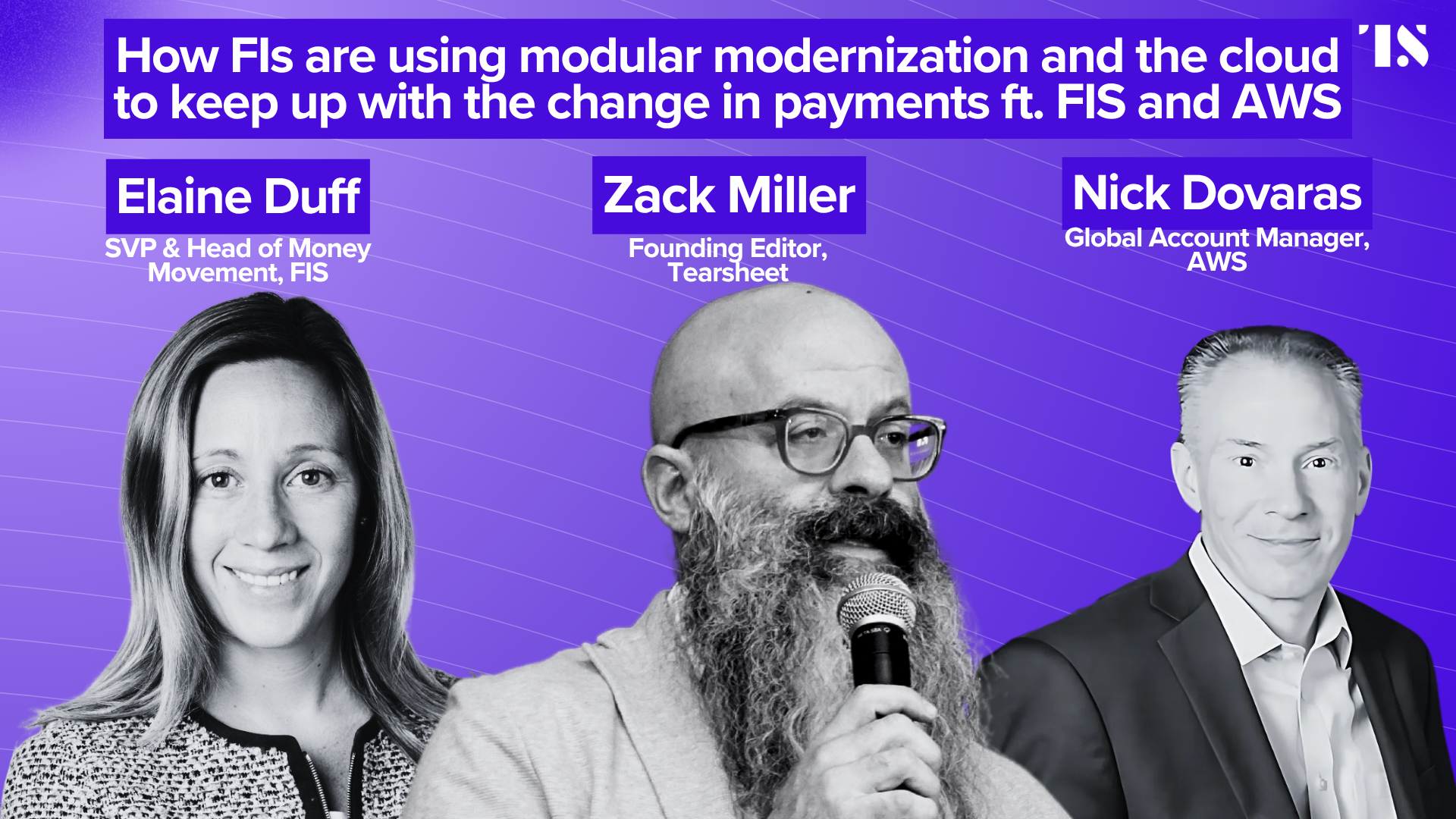How FIs are using modular modernization and the cloud to keep up with the change in payments ft. FIS and AWS
- The payments landscape is experiencing regulatory upheaval, forcing financial institutions to rethink their approach to money movement modernization.
- Dive into this episode to hear about how financial institutions are navigating regulatory pressures through modular modernization strategies.

The payments landscape is experiencing regulatory upheaval, forcing financial institutions to rethink their approach to money movement modernization. With ISO message format changes, Swift updates, and evolving fraud requirements hitting simultaneously, banks are facing a complex web of compliance demands that require immediate attention.
“The regulatory agenda for money movement is probably one of the most aggressive we have,” said Elaine Duff, SVP and Head of Money Movement at FIS. “It’s across the globe. We’re seeing the ISO message intended to help firms standardize their messaging, become more efficient, and make their operations much more standardized.”
Yet the scale of change extends far beyond simple messaging updates. The oncoming change affects fraud tools, digital channels, reporting formats, and entire operational workflows. For many institutions, the traditional rip-and-replace approach to modernization has become both financially and operationally untenable.
Nick Dovaras, Global Account Manager at AWS, emphasized the broader pressures driving urgency: “There’s customer expectations as well. Customers are expecting 24/7, instant, and customer-friendly mobile applications that are connected to online systems.”
Dive into this episode to hear about how financial institutions are navigating regulatory pressures through modular modernization strategies. FIS’ Duff and AWS’ Dovaras break down the critical role embedded fraud protection is playing in real-time payments, and why cloud-based solutions are enabling banks to modernize their money movement capabilities without the risks of traditional rip-and-replace approaches.
Watch the episode
Listen to the episode
Subscribe: Apple Podcasts I SoundCloud I Spotify
Customer experience drives modernization priorities
Customer expectations for real-time, mobile-first experiences are reshaping modernization priorities. Instant payments capabilities represent a particularly significant opportunity for institutions to demonstrate immediate value to end users.
“Instant payments is a game changer,” Duff noted. “When the end consumer sends money and doesn’t know whether it’ll be three or four days before it’s going to be available in the other person’s account, as opposed to it appearing instant, that is a real-time benefit that they see right away.”
The user experience improvements extend beyond speed to include confirmation and transparency throughout the transaction process. Real-time notifications and status updates address fundamental customer anxieties around money movement, particularly for urgent transfers.
These experience improvements also serve strategic business objectives by reducing operational overhead and improving competitive positioning against both traditional rivals and emerging fintech players.
Regulatory complexity demands a rethinking of implementation strategies
While consumer expectations apply steady pressure to improve the state of payments, the regulatory landscape consists of institutions with varying approaches to implementation, creating additional complexity in modernization planning. Some regulators have adopted co-existence models that allow gradual transitions, while others require “big bang” implementations that fundamentally alter operations overnight.
“Different regulators are taking positions of co-existence, where you can start sending messages in the new format but still rely on the old,” Duff explained.
This regulatory inconsistency has created disparity in institutional readiness across the industry. Surveys conducted by regulators reveal that while most institutions acknowledge the scope of change as manageable, the different implementation approaches have become the primary readiness hurdle across the industry.
Modular modernization reduces implementation risk
Due to the complexity, most players are staying away from complete overhauls and taking an iterative approach. This strategy allows banks to prioritize high-impact areas while managing risk and demonstrating measurable returns on investment.
“What we’re trying to do is talk to clients about the value of a payment hub, not just having single rail software solutions,” Duff said. “They can understand whether it’s a two-year, a three-year, or a five-year process to think about their wires, their ACH, and instant payments, and they can do this one at a time.”
Dovaras highlighted the risk management benefits of this layered approach: “The landscape is littered with big projects that were never finished. So it’s really about risk and reward. It may be that pieces of the monolithic application never get moved.”
The modular strategy enables institutions to target specific operational pain points, such as reducing staff requirements or improving straight-through processing rates, while building toward broader modernization goals. Cloud deployment models have made this phased approach more feasible by reducing infrastructure barriers to implementation.
Fraud protection requires proactive integration
The acceleration toward real-time payments has created new fraud vectors that require embedded protection rather than post-transaction monitoring. The traditional approach of adding fraud detection as an afterthought has proven inadequate for instant payment environments.
“Most people were offering instant payments without thinking about fraud as an embedded solution,” Duff explained. “The uniqueness of putting our solution in the AWS cloud is that we’re able to bring in fraud solutions to be inline. Inline means you’re doing the fraud check at the time of the transaction within the five-second window.”
Dovaras emphasized the importance of proactive monitoring: “There’s real-time transaction monitoring, being able to look for unusual or suspicious activity. Also, dark web monitoring, looking for trends that might hit us later. We call that seeing around corners.”
The education gap around fraud preparedness remains significant, with many institutions underestimating risk based on initial transaction volumes. However, consumer adoption of instant payments typically accelerates rapidly once available, quickly reaching volumes that require sophisticated fraud detection capabilities.
Technology partnerships enable comprehensive solutions
The complexity of payments modernization increasingly requires partnerships between traditional financial technology providers and cloud infrastructure companies. These collaborations enable institutions to access both specialized payments expertise and scalable technology platforms.
The combination allows for solutions that address both immediate regulatory requirements and longer-term strategic objectives around CX and operational efficiency.
Cloud deployment has a second advantage: enabling modular implementation approaches that play a critical role in meeting regulatory demands while managing implementation risks.
“We were very intentional to say the fraud solution is going to be bundled and part of the offering as a way that you can remove it if needed,” Duff said. “But our high recommendation is that this should be there from the start.”
As regulatory pressures continue to intensify and customer expectations evolve, the institutions that approach modernization strategically and find partners that can help prioritize among multiple objectives, package embedded fraud protection, and implement modernization without widening the aperture of risk will be best positioned to succeed in the rapidly changing payments landscape.


